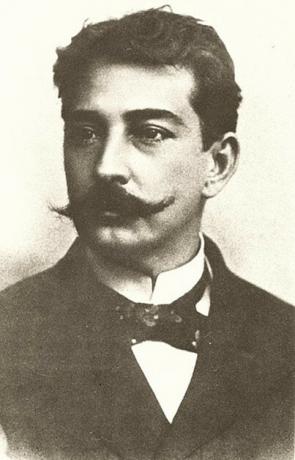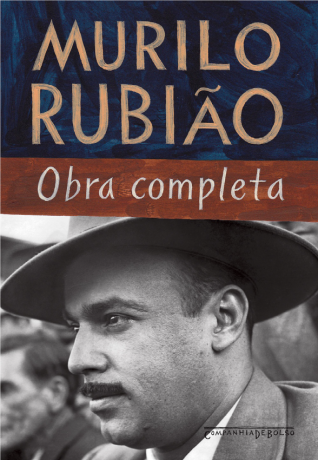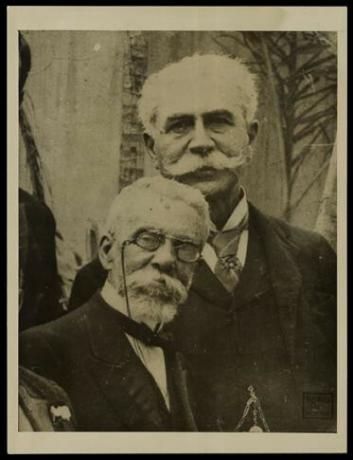Allusionsorrel it was the main author of naturalistic side in Brazil and the first writer to make a living from literature in the country. expert portraitist of social types, wrote numerous works, including novels, Tales, chronicles and plays, as well as being a cartoonist and caricaturist.
His literary production is concentrated between the years 1882 and 1895, approximately, with an emphasis on the famous novel the tenement, required reading for admission to several Brazilian universities, as well as for the understanding of Rio's social structures in the late nineteenth century, based on economic exploitation and perpetuation of inequalities.
Read too: Guimarães Rosa – reinventer of the Portuguese language
Biography of Aluísio de Azevedo
Born in São Luís do Maranhão (MA), on April 14, 1857, Aluísio Azevedo was the son of D. Emília Amália Pinto de Magalhães and the Portuguese vice-consul David Gonçalves de Azevedo.
From a very young age, he showed a great interest in drawing and painting, which led him to move to Rio de Janeiro in 1876, in order to enroll in the Imperial Academy of Fine Arts. To stay in the capital,
he drew cartoons for newspapers The Figaro, The Illustrated Week, The Mequetrefe, and Zig-Zag. He also sketched scenes from novels.
After his father died in 1878, he returned to São Luís, where starts your writing career the following year, with the romance a woman's tear, still in the mold of romantic aesthetics. He also works for the foundation of the newspaper O Pensador, an anticlerical publication and abolitionist.
In 1881, he launched his first naturalistic novel, the mulatto, addressing the issue of racial prejudice. Well received at court, despite the theme of the work being considered scandalous, Aluisio embarks back to Rio de Janeiro, determined to earn a living as a writer.
Back to the capital of the Empire, produces several serials, which guaranteed its survival. In between these publications, usually melodramatic and romantic, devoted himself to research and naturalistic writing, which consecrated him as a great Brazilian author. It was at this time that he released his main works, pension house (1884) and the tenement (1890).
Approved in a competitive examination for the position of consul in 1895, abandons the literary career. He resides in Spain, Japan, England, Italy, France, Uruguay, Paraguay and Argentina, where he died in Buenos Aires on January 21, 1913.
Do not stop now... There's more after the advertising ;)
Literary Characteristics of Aluísio Azevedo
Aluísio Azevedo's work is split in two moments: the first one still follows the formula of melodramas romantic — although the aesthetic was already in frank decay, they were texts in the form of serials that snatched many sales, enabling the author to support himself only with literature, a rare case in the Brazil. The second moment refers to works written in the light of naturalist aesthetics — and it was these works that made the author prominent in the national canon.
Azevedo reverberates in his naturalist work the influence of Hippolyte Taine's deterministic ideas, who understood that the understanding of the human being and of history was based on three foundations, namely, the environment, the race and the historical moment. It is based on this theoretical arsenal that Azevedo builds the plot of his naturalist novels, as in the tenement — the environment (the tenement itself) conditions the group (the race), determining human relations within the collective housing.
was also great admirer of positivism, doctrine of thought disseminated by Auguste Comte, which, among other characteristics, defended the scientism, so that Azevedo understands the human being as an object of scientific study. To write the aforementioned the tenement, the author visited several of these installations in Rio de Janeiro, carefully observing the relationships, customs and daily dialogues of its inhabitants.
He was also influenced by Émile Zola, the forerunner of French naturalism, putting into practice the idea of a literature that went beyond observation: the author becomes an experimenter, working with social facts and seeking to prove the influence of the environment and facts on human development. In addition to Zola, the author was inspired by Eça de Queirós, mainly for the detailed description of urban environments and their characters.
Azevedo wrote chronicles and theatrical plays, but from his work the prose novels, principally the mulatto (1881), considered the first Brazilian naturalist novel; pension house (1884) and the tenement (1890). The following characteristics are recurrent in his literature:
- approach to everyday reality;
- simple language and predominantly descriptive;
- characters from the lower strata of society;
- animalization of characters;
- morally and socially degraded situations and characters;
- descriptions that tend to be grotesque;
- presence of themes such as prostitution, addictions, promiscuity, adultery and racial prejudice;
- social criticism and pessimism.
See too: Realism in Brazil and its differences with the naturalist tendency
Works by Aluísio Azevedo
Affairs
- a woman's tear (1880)
- the mulatto (1881)
- Tijuca Mysteries [reprinted with the title Girandola of loves] (1882)
- memories of a convict [reprinted with the title Countess Vesper] (1882)
- pension house (1884)
- Philomena Borges (1884)
- The man (1887)
- the owl (1890)
- the tenement (1890)
- Alzira's shroud (1894)
- mother-in-law's book (1895)
theater
- The crazy (1879)
- fleur-de-lis (1882)
- house of prayers (1882)
- the caboclo (1886)
- poisons that cure (1886)
- the republic (1890)
- a case of adultery (1891)
- In the act (1891)
Tales
- Devils (1895)
- Footprints (1897)
- the black bull [shorts, letters and chronicles in ed. posthumous] (1938)
See too: Euclides da Cunha – pioneer in bringing literature and history closer together
Considerationsabout the work of Aluísio de Azevedo
the mulatto
the mulattoand thedebut of naturalismin Brazilian literature. The plot is starred by Raimundo, son of a white father and enslaved mother, who grew up with intellectual education and possessions, studying law in Portugal. O omniscient narrator gives the character description:
“Raimundo was twenty-six years old and would have been a type, if it weren't for the big blue eyes he had pulled from his father. Very black hair, glossy and frizzy; brown and amulatto complexion, but thin; pale teeth that gleamed under the blackness of his mustache; tall, elegant stature; wide neck; straight nose and spacious forehead. The most characteristic part of his face were his eyes: large, bushy, full of blue shadows; ruffled black eyelashes, eyelids a moist, vaporous purple; the eyebrows, very drawn on the face, like India ink, brought out the freshness of the epidermis, which, in place of a shaved beard, resembled the soft, transparent tones of a watercolor on white paper. rice."
When returning, do not understand why is he not accepted in high society Maranhão, especially after wanting the hand of his cousin, Ana. The family and members of the Catholic Church are vehemently opposed to the couple's union.
“[...] I noticed with disgust that, always and everywhere, they received him embarrassed. Not a single invitation to a ball or a simple soiree reached her hands; they often cut off the conversation when he approached; they were squeamish in speaking in his presence of matters which, moreover, were innocent and common; at last they isolate him and the unfortunate man, convinced that he was gratuitously disliked throughout the province, buried himself in his room and only go out to exercise, go to a public meeting, or when some of his business calls him to road."
The intrigue, therefore, consists of in a romantic melodrama, but the couple's misfortunes are already treated in a different way, different from the romantic school. The author's desire is to prove the presence of racial prejudice in Brazilian society, in their families and institutions, which he does, mainly, through descriptions almost always grotesque.
Biting caricatures of the rich and rude merchant, the pious and angry old woman, and the relaxed cleric, according to Alfredo Bosi, make up the picture of the characters. It is an open flag against conservatism and the corruption of the clergy, that corroded the society of Maranhão.
pension house
pension house it was the book that consecrated Aluísio Azevedo in naturalist aesthetics. From reality came the raw material for the novel, starring Amâncio, a student who goes to Rio de Janeiro and stays in a boarding house. Stronghold of student bohemia, the pension is stage of the most diverse promiscuities, pathologies and degrading behaviors, whose description is the consolidation of Azevedo's realist-naturalist procedures:
“The room breathed a sad air of neglect and bohemianism. It made a bad impression to be there: Amancio's vomit dried up on the floor, souring the room; the crockery, which had been served at the last dinner, still covered in curdled fat, appeared inside an abominable tin, full of bruises and rusty food... In one corner, dirty clothes were piled up; in another rested a coffee machine, beside a bottle of wine spirit. On the headboards of the three beds and along the walls, over faded old newspapers, hung cashmere trousers and tailcoats:... Here and there crushed cigarette butts and withered spit.”
He gets involved with Amelia, thanks to the plan devised by the girl's mother, Madame Brizard, owner of the pension, interested in taking advantage of the protagonist's fortune:
“It's a precious find! He hasn't arrived from the North for two months yet, he's been groping! We've been talking for a long time: — he's an only child and he has a fortune to inherit! Ah! You can't imagine: just because of the death of her grandmother, who is very old, I believe it goes beyond four hundred contos!”
The description of morally degraded characters, hostile, combined with a vicious family environment, reveals the hypocrisies rooted in Brazilian society. Mediocrity and the bourgeois mentality, which values money in the first place, therefore has no scruples, are approached in a deterministic way — the environment influences the disastrous fate of the characters.
the tenement
the tenement it's themain novel by Aluísio Azevedo, in which the author vehemently developed the naturalistic assumptions. Based on the picture — the tenement space — the figures are developed. It is the collective scenes of the psychological types of its inhabitants that weave the tenement as the main character of the novel.
Portuguese property João Romão (image of the European explorer, who get rich at the expense of the misery of others), consisted of 95 little houses, paid for per month, and tubs for laundresses, paid for per day, all in advance. The laundresses who lived there did not pay for the tubs. So this place is described:
“And in that steaming, sodden earth, in that hot, muddy moisture, it began to worm, to swarm, to grow, a world, a living thing, a generation that seemed to sprout spontaneously, right there, from that lament, and multiply like larvae in the manure."
It is clearly seen, in this and other passages, descriptions that bring human social life closer to the animalistic, from the organic, as if governed by physiological laws, making abundant use of deforming metaphors of space and characters.
This living collection of the collective housing was also a mixture of races, all exploited by the landlord João Romão. It is an allegory of the economic situation in Brazil as a whole, where whites, blacks and mestizos were equally exploited by the Portuguese money earner, who ascends socially and economically sucking the work of others.
video class of literary analysis of the tenement
O sex is a recurring theme and also a naturalistic premise. Animalized and hypersexualized, the characters are stripped throughout the novel, emphasizing their desires, addictions and physiology. THE menstruation — a taboo for the time — is described as never before in Brazilian literature. Adultery and homosexuality scenes (at the time, considered a pathology) are also abundant, as well as the presence of prostitution and the figure of the virginal girl who ends up becoming a prostitute.
See an excerpt in which the author attributes animal conditions to the character Léonie:
“Now she was stripping herself all over, clenching her teeth, her flesh quivering in twitches of spasm; while the other above, maddened with lust, irrational, ferocious, twirled, in mare's humps, snorting and whinnying. And she thrust her stiff tongue through his mouth and through his ears, and crushed his eyes under her oiled kisses of foam, and bit the lobe of her shoulders, and gripped her hair convulsively, as if she wanted to pull it out. handfuls. Until, with a stronger gasp, he devoured her in an embrace of the whole body [...].”
by Luiza Brandino
Literature teacher


